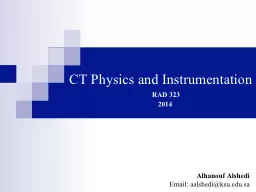

aalshediksuedusa CT Physics and Instrumentation RAD 323 2014 Mid terms 1 and 2 202040 Reportassignment 10 Case presentation 5 Attendance 5 Final 40 Total 100 Topics to be covered ID: 779872
Download The PPT/PDF document "Alhanouf Alshedi Email:" is the property of its rightful owner. Permission is granted to download and print the materials on this web site for personal, non-commercial use only, and to display it on your personal computer provided you do not modify the materials and that you retain all copyright notices contained in the materials. By downloading content from our website, you accept the terms of this agreement.
Slide1
Alhanouf AlshediEmail: aalshedi@ksu.edu.sa
CT Physics and Instrumentation
RAD 323
2014
Slide2Mid terms 1 and 2
20+20=40
Report/assignment
10
Case presentation
5
Attendance
5
Final
40
Total
100
Slide3Topics to be covered1
st
Lecture:
Introduction
to C.T and Historical prospective,
CT
physical
principle.
2
nd
Lecture
: CT instrumentation and x-ray system and Data acquisition .
3
rd
Lecture
: Detectors and detector characteristics.
4
th
Lecture
:
Factors affecting CT image, Digital fundamentals and Image domains.
1
st
Midterm Exam
5
th
Lecture
: Image reconstruction.
6
th
Lecture
: Image Post-processing and Manipulation tools and Windowing.
7
th
Lecture
: CT Computer and Image processing system.
8
th
Lecture
: Quality control and Patient dose.
2
nd
Midterm Exam.
9
th
Lecture:
Advances in CT slip ring technology.
CT visit will be scheduled with KKUH.
Student`s Presentations .
Slide4Useful BooksE. Seeram
, Computed Tomography: Physical Principles, Clinical Applications, and
Quality.
W. A.
Kalender
, Computed Tomography: Fundamentals, System Technology, Image
Quality.
Slide5Introduction to Computed Tomography and Historical
Prospective
1
st
Lecture
Alhanouf
Alshedi
Email:
aalshedi@ksu.edu.sa
Slide6What is Tomography?
Tomography
comes from the Greek word
tomos
meaning “section” or “cut” and graph meaning write. A conventional tomogram is an image of a section of a patient parallel to the film.
With the development of technologies, parallel sections were overcome by cross-sections and conventional tomography was replaced with
computerised
tomography C.T.
Slide7Slide8How are x-rays produced?
Slide9Slide10Production of X-rays
The filament is heated by passing an electrical current through it. The filament then emits electrons by thermionic emission
.
The electrons are then repelled by the negative cathode and attracted by the positive anode and bombard the target
.
Each electron arrives at the target with a kinetic energy, as the electrons penetrate several micrometers into the target, they lose their energy by several processes.
Slide11Cont. Heat.
Bremsstrahlung radiation.
Characteristic x-rays.
Total number of electrons converted to heat is 99% and only 1% of the electrons are converted to x-rays
Heat:
When an electron interacts with an outer loose electron, it loses a small amount of its energy. This results in unwanted heat.
Slide122. Characteristic X-raysThe
high energy electron can also cause an electron
from an inner shell to
be knocked out from its place.
This
vacancy is filled by an electron further out from the nucleus. The well defined difference in binding energy, characteristic of the material, is emitted as a
monoenergetic
photon. When detected this X-ray photon gives rise to a characteristic X-ray line in the energy spectrum
.
Slide13Slide143. BREMSSTRAHLUNG RADIATION
An incoming free electron gets close to the nucleus, the strong electric field of the nucleus will attract the electron, changing direction and speed of the electron. The Electron looses energy which will be emitted as an X-ray photon.
X-rays originating from this process are called bremsstrahlung.
Bemsstrahlung
is a German word meaning: "
Bremse
" means "brake and "
Strahlung
" means "radiation“.
Slide15Slide16What is CT?
In
principle, Computed Tomography (CT) measures the attenuation of beams passing through sections of the body from hundreds of different angles, and then from these measurements a computer is employed to reconstruct pictures of the bodies interior.
CT uses the same principle as radiography,
i.e
x-ray beam passes through the
pt
body.
CT produces a volume of data that can be manipulated in order to demonstrate various bodily structures based on their ability to attenuate the X-ray beam.
Slide17Slide18Cont.
While a typical digital image is composed of pixels (picture elements), a CT slice image is composed of
voxels
(volume elements). Taking the analogy one step further, just as a loaf of bread can be reconstituted by stacking all of its slices, a complete volumetric representation of an object is obtained by acquiring a contiguous set of CT slices.
Slide19CT Image
Brain CT images.
Slide20Cont.
The gray levels in a CT slice image correspond to X-ray attenuation, which reflects the proportion of X-rays scattered or absorbed as they pass through each voxel.
X-ray attenuation is primarily a function of X-ray energy and the density and composition of the material being imaged.
Slide21How it works?
Slide22Why do we need CT?
Limitations of radiography:
Superimposition of structures, especially structures that only differ slightly in density e.g. tumor (limited contrast resolution).
Qualitative rather than quantitative.
Limitations of conventional tomography:
Contrast degradation.
Image blurring.
Limitations of film itself as a detector.
Slide23How does C.T overcome the limitations of radiography and tomography?
X-ray beam is transmitted through a specific cross-section removes superimposition
.
X-ray beam is tightly collimated scatter and contrast.
X-ray beam is detected by special detectors which are quantitative & can measure subtle differences in tissue contrast.
Ability to manipulate and adjust image after scanning (digital technology)
Slide24Any Question?
Thank You